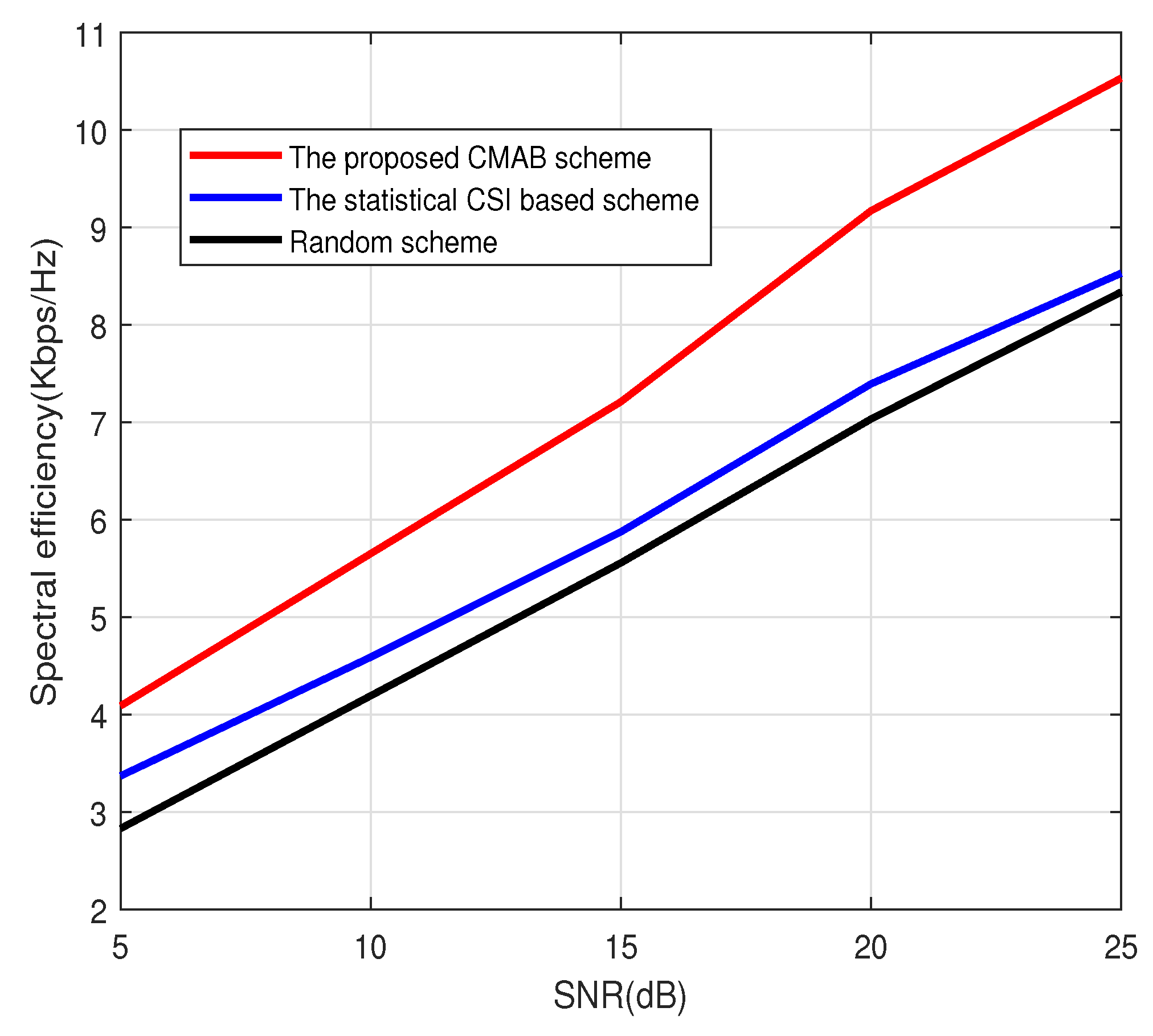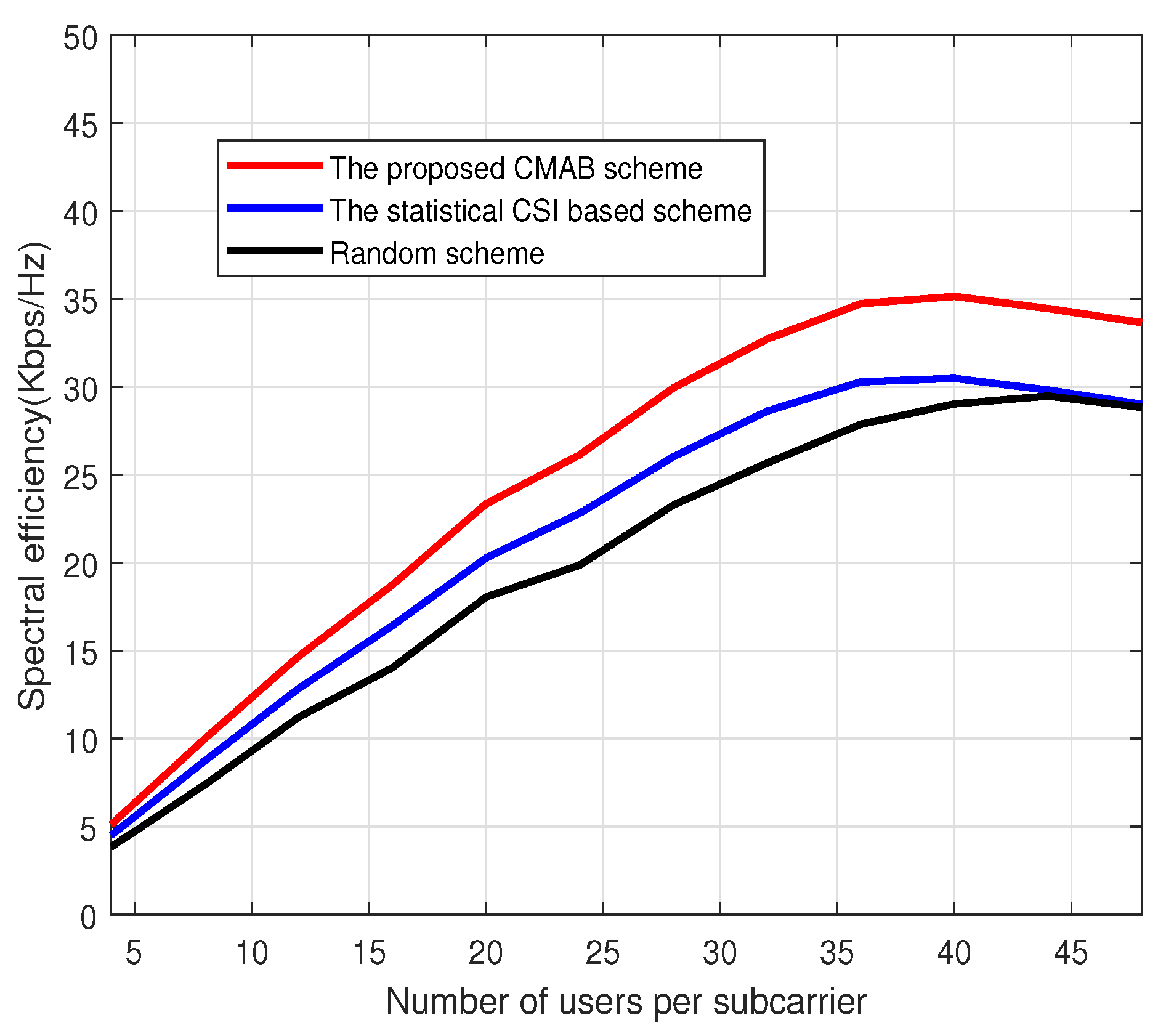Spectrum Allocation and User Scheduling Based on Combinatorial Multi-Armed Bandit for 5G Massive MIMO
Abstract
:1. Introduction
2. Preliminaries
2.1. System Model
2.2. The Description of the CMAB
3. Two-Stage Spectrum Allocation and User Scheduling Scheme
3.1. The User Scheduling Problem Formulation
3.2. Linear UCB User Scheduling Algorithm
| Algorithm 1: The CMAB-based user scheduling algorithm |
|
3.3. Spectrum Allocation Algorithm Based on Statistical CSI Grouping
| Algorithm 2: The spectrum allocation based on the improved K-means grouping method |
|
4. Simulation Results
5. Conclusions
Author Contributions
Funding
Institutional Review Board Statement
Informed Consent Statement
Data Availability Statement
Conflicts of Interest
Abbreviations
| MIMO | multiple-input multiple-output |
| MAB | multi-armed bandit |
| CMAB | combinatorial multi-armed bandit |
| UCB | upper confidence bound |
| CSI | channel state information |
| BS | base station |
| NC | non-coherent |
| TDD | time-division multiplex |
| OFDM | orthogonal frequency-division multiplexing |
| MMSE | minimum mean square error |
| CSIA | channel state information on the angular domain |
| SNR | signal-to-noise ratio |
| CCM | channel covariance matrix |
| FDD | frequency-division duplex |
References
- Wu, Q.; Wang, W.; Li, Z.; Zhou, B.; Huang, Y.; Wang, X. Spectrum chain: A disruptive dynamic spectrum-sharing framework for 6G. Sci. China Inf. Sci. 2023, 66, 130302. [Google Scholar] [CrossRef]
- Wang, W.; Qi, N.; Jia, L.; Li, C.; Tsiftsis, T.A.; Wang, M. Energy-efficient UAV-relaying 5G/6G spectrum sharing networks: Interference coordination with power management and trajectory design. IEEE Open J. Commun. Soc. 2022, 3, 1672–1687. [Google Scholar] [CrossRef]
- Yang, X.; Ma, S.; Jin, S. Antenna selection for asymmetrical uplink and downlink transceivers in massive MIMO systems. IEEE Trans. Wirel. Commun. 2023; in press. [Google Scholar] [CrossRef]
- Larsson, E.G.; Edfors, O.; Tufvesson, F.; Marzetta, T.L. Massive MIMO for next generation wireless systems. IEEE Commun. Mag. 2014, 52, 186–195. [Google Scholar] [CrossRef]
- Liu, S.; Huang, X. Sparsity-aware channel estimation for mmWave massive MIMO: A deep CNN-based approach. China Commun. 2021, 18, 162–171. [Google Scholar] [CrossRef]
- Yuan, M.; Wang, H.; Yin, H.; He, D. Alternating optimization based hybrid transceiver designs for wideband millimeter-wave massive multiuser MIMO-OFDM systems. IEEE Trans. Wirel. Commun. 2023; in press. [Google Scholar] [CrossRef]
- Agiwal, M.; Roy, A.; Saxnea, N. Next generation 5G wireless networks: A comprehensive survey. IEEE Commun. Surv. Tutor. 2016, 18, 1529–1543. [Google Scholar] [CrossRef]
- Anarakifirooz, E.; Loyka, S. The robustness of favorable propagation in massive MIMO to location and phase errors. IEEE Trans. Wirel. Commun. 2023; in press. [Google Scholar] [CrossRef]
- Baeza, V.M.; Armada, A.G. Orthogonal versus Non-Orthogonal multiplexing in Non-Coherent Massive MIMO Systems based on DPSK. In Proceedings of the Joint European Conference on Networks and Communications & 6G Summit (EuCNC/6G Summit), Porto, Portugal, 8–11 June 2021; pp. 101–105. [Google Scholar]
- Manolakos, A.; Chowdhury, M.; Goldsmith, A. Energy-based modulation for noncoherent massive SIMO systems. IEEE Trans. Wirel. Commun. 2016, 16, 7831–7846. [Google Scholar] [CrossRef]
- Baeza, V.M.; Armada, A.G.; Zhang, W.; El-Hajjar, M.; Hanzo, L. A noncoherent multiuser large-scale SIMO system relying on M-ary DPSK and BICM-ID. IEEE Trans. Veh. Technol. 2018, 67, 1809–1814. [Google Scholar] [CrossRef]
- Ngo, K.H.; Guillaud, M.; Decurninge, A.; Yang, S.; Schniter, P. Multi-user detection based on expectation propagation for the non-coherent SIMO multiple access channel. IEEE Trans. Wirel. Commun. 2020, 19, 6145–6161. [Google Scholar] [CrossRef]
- Zhang, Z.; Jiao, C.; Zhong, C. Impact of mobility on the uplink sum rate of MIMO-OFDMA cellular systems. IEEE Trans. Commun. 2017, 65, 4218–4231. [Google Scholar] [CrossRef]
- Anand, A.; Murthy, C.R. Impact of subcarrier allocation and user mobility on the uplink performance of multiuser massive MIMO-OFDM systems. IEEE Trans. Commun. 2022, 70, 5285–5299. [Google Scholar] [CrossRef]
- Hong, M.; Hwang, I.; Heo, J.; Hong, D. A new scheduling algorithm for time-varying MIMO channels with a channel aging metric. In Proceedings of the IEEE Consumer Communications & Networking Conference (CCNC), Las Vegas, NV, USA, 8–11 January 2023. [Google Scholar]
- Jin, L.; Gu, X.; Hu, Z. Low-complexity scheduling strategy for wireless multiuser multiple-input multiple-output downlink system. IET Commun. 2023, 5, 990–995. [Google Scholar] [CrossRef]
- Shehata, M.; Crussire, M.; Hlard, M.; Pajusco, P. Leakage based users selection for hybrid beamforming in millimeter wave MIMO. In Proceedings of the Annual International Symposium on Personal, Indoor and Mobile Radio Communications, Bologna, Italy, 9–12 September 2018; pp. 1144–1150. [Google Scholar]
- Bu, G.; Jiang, J. Reinforcement learning-Based user scheduling and resource allocation for massive MU-MIMO system. In Proceedings of the IEEE/CIC International Conference on Communications in China, Istanbul, Turkey, 11–13 August 2019; pp. 1–6. [Google Scholar]
- Thet, N.M.W.; Baykas, T.; Ozdemir, M.K. Performance analysis of user scheduling in massive MIMO with fast moving users. In Proceedings of the 30th Annual InternationalSymposium on Personal, Indoor and Mobile Radio Communications, Changchun, China, 8–11 September 2019; pp. 641–646. [Google Scholar]
- Yoon, S.; Lee, S.J. Improved Hierarchical Codebook-Based Channel Estimation for mmWave Massive MIMO Systems. IEEE Wirel. Commun. Lett. 2022, 11, 2095–2099. [Google Scholar] [CrossRef]
- Yang, B.; Yu, Z.; Lan, J.; Zhang, R.; Zhou, J.; Hong, W. Digital beamforming-based massive MIMO transceiver for 5G millimeter-wave communications. IEEE Trans. Microw. Theory Tech. 2018, 66, 3403–3418. [Google Scholar] [CrossRef]
- Sutton, R.S.; Barto, A.G. Reinforcement Learning: An Introduction; The MIT Press Cambridge: London, UK, 2018. [Google Scholar]
- Song, Y.; Liu, C.; Zhang, W.; Liu, Y.; Zhou, H.; Shen, X. Two stage beamforming in massive MIMO: A combinatorial multi-armed bandit based approach. IEEE Trans. Veh. Technol. 2023, 72, 6794–6799. [Google Scholar] [CrossRef]
- Vershynin, R. High-Dimensional Probability—An Introduction with Applications in Data Science; University of California: Irvine, CA, USA, 2020. [Google Scholar]





| Notations | Parameters |
|---|---|
| B | Bandwidth |
| F | The number of subcarriers |
| The channel vector between the BS and user k in slot t at subcarrier f | |
| The transmitted signal from user k in slot t at subcarrier f | |
| The digital combiner in slot t at subcarrier f | |
| Gaussian noise vector in slot t at subcarrier f | |
| The number of paths of user k at the f-th subcarrier | |
| The angle of the l-th path of user k in slot t at subcarrier f | |
| The complex path gain | |
| The steering vector | |
| the wavelength | |
| d | Antenna spacing |
| The variance of the Gaussian noise | |
| The power gain of user k in slot t at subcarrier f | |
| The power gain of user k | |
| The angle of the l-th path of user k in the t-th slot | |
| The action | |
| The value of the action in slot t | |
| The reward in slot i | |
| The set of selected users in slot t at subcarrier f | |
| The channel matrix of the selected users in slot t at subcarrier f | |
| The set of users selected in slot t | |
| The pilot signal at subcarrier f | |
| The received signal at subcarrier f | |
| The noise matrix in slot t at subcarrier f | |
| The set of users selected in slot t | |
| The UCB value of the super arm | |
| The mean reward of action i slot t | |
| The discrete Fourier transform matrix at subcarrier f | |
| The channel vector in the angular domain | |
| The statistical CSI on the angular domain | |
| The chord distance between and | |
| The eigenvectors corresponding to the non-zero eigenvalues of (Y) |
Disclaimer/Publisher’s Note: The statements, opinions and data contained in all publications are solely those of the individual author(s) and contributor(s) and not of MDPI and/or the editor(s). MDPI and/or the editor(s) disclaim responsibility for any injury to people or property resulting from any ideas, methods, instructions or products referred to in the content. |
© 2023 by the authors. Licensee MDPI, Basel, Switzerland. This article is an open access article distributed under the terms and conditions of the Creative Commons Attribution (CC BY) license (https://creativecommons.org/licenses/by/4.0/).
Share and Cite
Dou, J.; Liu, X.; Qie, S.; Li, J.; Wang, C. Spectrum Allocation and User Scheduling Based on Combinatorial Multi-Armed Bandit for 5G Massive MIMO. Sensors 2023, 23, 7512. https://doi.org/10.3390/s23177512
Dou J, Liu X, Qie S, Li J, Wang C. Spectrum Allocation and User Scheduling Based on Combinatorial Multi-Armed Bandit for 5G Massive MIMO. Sensors. 2023; 23(17):7512. https://doi.org/10.3390/s23177512
Chicago/Turabian StyleDou, Jian, Xuan Liu, Shuang Qie, Jiayi Li, and Chaoliang Wang. 2023. "Spectrum Allocation and User Scheduling Based on Combinatorial Multi-Armed Bandit for 5G Massive MIMO" Sensors 23, no. 17: 7512. https://doi.org/10.3390/s23177512
APA StyleDou, J., Liu, X., Qie, S., Li, J., & Wang, C. (2023). Spectrum Allocation and User Scheduling Based on Combinatorial Multi-Armed Bandit for 5G Massive MIMO. Sensors, 23(17), 7512. https://doi.org/10.3390/s23177512





